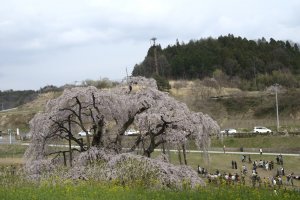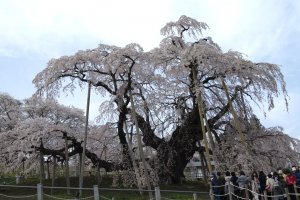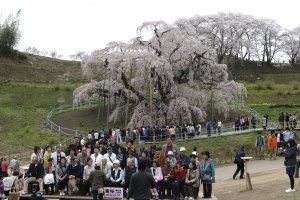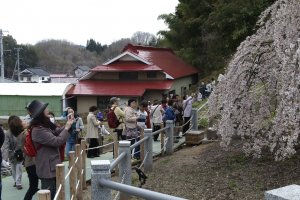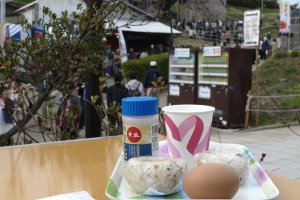Miharu Takizakura stands on the slope of a hill. By its sheer height and color, it stands out surrounded by plots of vegetables and wildflowers. It is located in a farming valley about seventy kilometers from the nuclear power plant.
Coming to visit a tree and view its blossoms is almost a kind of spiritual journey. I have come to witness a miracle—the tree has survived the earthquake, tsunami, and nuclear power plant disaster. It is a living testament to resilience and enduring hope.
From a distance, I behold the sacred tree. It is all pink, all blossoms and no leaves. Its blossoms are flowing like eternal water falls. Its branches are spread-eagled, grateful under the wide, soft, and overcast skies of Fukushima. From top to bottom, the blossoms are in full bloom! It is the biggest blossoming cherry tree I have ever seen.
People who are fascinated by cherry blossoms always fascinate me. It is fascinating just to watch them. People from all ages and lifestyles come to see Miharu Takizakura.
I go near the tree and walk up the path. At the end of the path is a small wooden shrine. Beside it is a wooden offertory box. People throw in coins, stand before it, bow, clap their hands, bow, and offer prayers as though they are visiting a real shrine.
Under the tree, wooden stakes prop up and keep its smaller branches from breaking or touching the ground. Years ago, according to reports, a snow blizzard had threatened to break its branches.
Miharu Takizakura’s trunk is massive—it will take at least eight people to fully embrace its whole body. But it is not very embraceable—its bark is rough, gnarled, twisted, and sharp. Around the tree is a carpet of clover with tiny white flowers. There are also some dandelions among them. At the foot of its trunk, I notice, there is an opening, a kind of small cave. By the entrance, there is a miniature shrine made of stone. From this tiny cave, later in the afternoon, I would see a black striped cat emerging. A cat lives among the roots and under the heavenly weight of the most adored and sacred cherry tree in Japan!
The massiveness of the tree is inversely proportional to the size of its flowers. Its five-petal blossoms, in clusters, are almost half the size of the common sakura. Commenting on its diminutiveness, one lady on coming close to the blossoms remarks: “Chit-chai desu ne.” How tiny they are!
I keep on falling in love with cherry blossoms. I keep on visiting places just to see them.
I remain under the cherry blossoms. I find myself talking to an imaginary person:
Under the cherry blossoms I would like to invite you
To a conversation.
Solitary amid the crowd, I go up to the top of the hill where there are more cherry trees but whose blossoms have different numbers of petals, shapes, and colors. Their complexions are subtle variations of pink and white. I walk around the neighboring farm and I come to a cluster of cherry trees on another hill. As I get nearer, I can see that it is a graveyard. The departed souls, I whisper to the wind, have probably resurrected as cherry blossoms.
Up and down the hill, I spend the whole day taking pictures, marveling, immersing, and infusing myself with all the scents of cherry blossoms and elements under the Fukushima sky.
Along the village road that leads to Miharu Takizakura are family stalls selling local food, drinks, crafts, and plants. At a stall selling amazake, I order a cup. A lady cheerfully serves me. The drink comes in a paper cup.
"Mada atsui desk," she warns me, it is still hot. "Okawari wa tada desk," she says: The next cup would be free.
On a bench behind the stall, I rest for a quiet celebration.
Amazake is made of fermented brown rice; creamy, it looks like gruel, and it contains a little alcohol. This is my lunch and I’m drinking it literally under a young cherry tree with blossoms in full bloom. I sip it slowly. It is sweet and it quenches my thirst and placates my hunger. I finish the cup. Plucking a little courage, I ask for the free refill. The lady behind the counter cheerfully and generously gives me another cup.
After a swig, I start a conversation. I came all the way from Yokohama, I tell her, but I’m originally from the Philippines. She thanks me, sincerely and profusely. Many people think, she says, that Fukushima is all nuclear power plant radiation. It isn’t. We still have the beautiful cherry blossoms; we are okay here. I want other people to know that. I want them to visit Miharu-machi again. I make a promise that I will come back here next year.
It is getting a little cold. The sun coming down behind the mountains is muted, softened, and made gentle by the Miharu-machi skies. I continue walking around the village. I stop at a farmer’s stall selling Takizakura seedlings. These are rare Takizakura seedlings, he says. I seldom sell them like this. These are the last of them.
The elderly farmer is getting ready to clear up.
On the spot, I decide to get two. The two seedlings stand up as high as my knees.
Many people are buying Takizakura seedlings. How charming it is to see an elegant lady carrying a young seedling of Miharu Takizakura!
With a camera bag, tripod, and two seedlings, I walk around and return to the main spot. In front of the ancient tree, I stand up. From a distance, a powerful spotlight is illuminating its blossoms. The flood of light may not be necessary for the blossoms but important for the camera and television. NHK, the national television, is going to live-broadcast nationwide the lighted-up beauties. The members of the NHK crew are busy setting up.
Once more, I behold the mystery of the Takizakura. Once upon a time, I tell her in silence, you were a tiny seedling. You have grown to be more than a thousand years old. May you continue to live longer and give joy to many more travelers and people from all walks of life.


